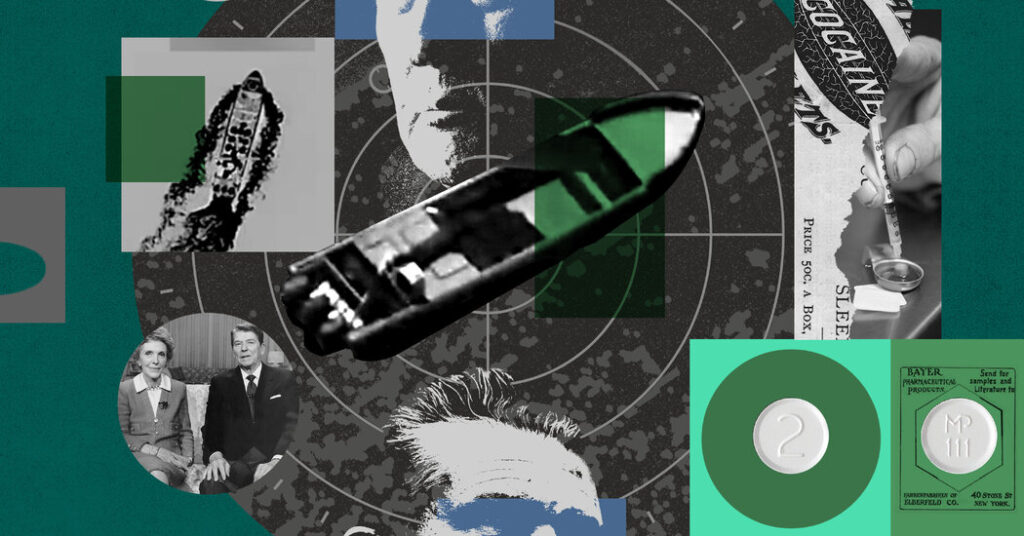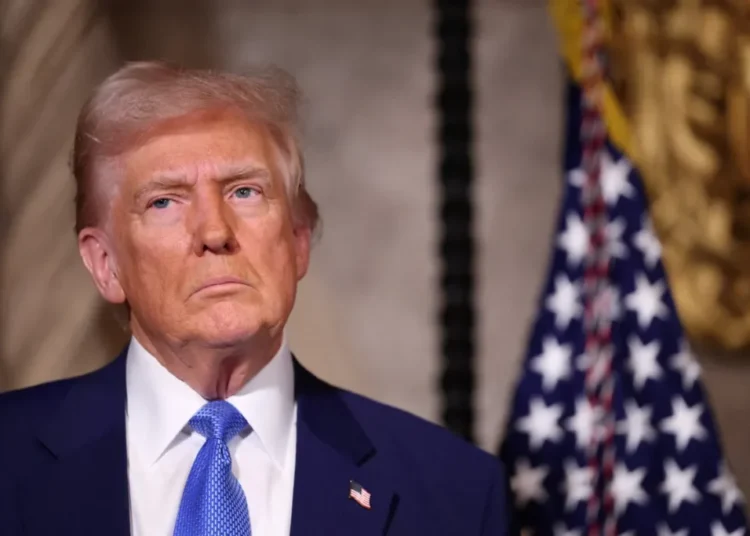It’s one of President Trump’s favorite stories: The Democrats weakened the borders, allowing Mexican drug cartels to smuggle fentanyl into the United States, where it devastated white suburban and rural communities. To stop this “evil scourge,” he has imposed tariffs on China for its role in fentanyl production. His administration is reportedly considering military strikes in Latin America. And Mr. Trump has built up the U.S. military presence in the Caribbean. “I think we’re just going to kill people that are bringing drugs into our country,” he told reporters of his campaign of deadly strikes.
The killing has already started. Since September, the military has carried out 20 strikes on boats supposedly smuggling drugs in the Caribbean and the eastern Pacific, killing at least 80 people. Defense Secretary Pete Hegseth celebrates these “lethal kinetic strikes” by posting aerial footage of the explosions on social media. Mr. Trump falsely boasts that each destroyed boat saves the lives of 25,000 Americans.
The brazenness is shocking. There is apparently no time to nitpick about imposing the death penalty on civilians never formally accused of a crime or to consider the destructive precedents of extending U.S. military force into the Americas.
The fentanyl story is based on an argument about history: The United States went from greatness to crisis because open-border Democrats betrayed the honest, hardworking people of America by exporting jobs and allowing in foreign drugs. Stopping the drugs, Mr. Trump wants us to believe, will let the wholesome, traditional American culture that he idealizes to flourish again. As a historian of drugs, I can tell you that this argument is wrong in almost every way.
There is no wholesome, traditional drug-free America that we can return to. Americans have always used a lot of drugs — even in the white suburbs and rural areas that Mr. Trump’s supporters call the “real America.”
The first drug crisis came in the Gilded Age of the late 19th century. In the unregulated, buyer-beware markets of that era, sales of pharmaceutical morphine, cocaine and heroin rose precipitously. Addiction rates skyrocketed, mostly among the white, propertied class of Americans who had ready access to a doctor.
New medical guidelines and federal laws curtailed the runaway opioid markets by the 1920s, but drug crises remained a persistent feature of American life. A combination of booming global trade, capital flight (“white flight”) and racial segregation led to repeated waves of heroin addiction in major cities from the 1950s to the 1970s. This “junkie” menace dominated the headlines, but non-urban America experienced even larger drug crises during the same period.
That’s because after pharmaceutical heroin and cocaine were reined in, their makers flooded markets with new drugs that did not face the same regulatory constraints. The first out of the gate were barbiturates, introduced in 1903, provoking warnings of “promiscuous use” by 1937 and contributing to the nation’s biggest wave yet of addiction and overdose by the 1950s. As barbiturates faded, they were replaced by “minor tranquilizers” such as Miltown, Valium and eventually Quaalude, which were among the best-selling medicines and the most common substances found in emergency room overdose victims of the 1960s and 1970s.
Meanwhile, after widespread military use in World War II, amphetamine burst onto the scene in the 1950s and 1960s as a popular energizer, antidepressant and diet pill, increasing the extent of addiction and related harms even further.
By 1967, an estimated 31 percent of women and 15 percent of men had used a sedative or a stimulant in the past year, with use most common among white and middle-class people.
A more complex story was unfolding with opioids. Many Americans had developed addiction before freewheeling markets were regulated in the early 20th century. But punitive narcotics enforcement focused on the urban working classes, leaving wiggle room for physicians practicing in rural regions. At least through the 1950s, my research suggests, an outright majority of Americans with addiction may have been rural and small-town residents quietly maintained on morphine by sympathetic physicians. One of the few major studies of nonurban opioid use during this period suggests that Kentucky had among the highest per capita rates of opioid addiction into the early 1960s.
In other words, “real America” is no stranger to drug crises, especially the areas served by what I call “white markets.” White markets are the familiar ones that sell the prescription psychoactive drugs in your medicine cabinet — that is, legal sales by pharmacists of drugs designated as medicines to the relatively privileged consumers designated as patients.
Unlike fully illegal “prohibition markets” where “drug dealers” sell very similar drugs, white markets are regulated for consumer safety. The Food and Drug Administration ensures quality ingredients and accurate labels, and physicians provide expert guidance on when and how to use. But white markets are in a dynamic, long-term game of cat-and-mouse between drug companies and drug regulators and, at times, these regulations are too weak to prevent sales booms and addiction crises.
The recent fentanyl crisis is just the latest and worst of this long history of American drug crises. It was initially caused by shifts in domestic white markets. Those shifts began in the 1990s and 2000s, when the U.S. opioid industry burst free of longstanding regulatory restraints and began to market powerful opioids like OxyContin as a mostly nonaddictive solution for an expanding range of painful conditions.
The United States truly did need new approaches to widespread undertreated pain, and unleashing the private sector to offer them had strong political appeal in the anti-regulatory zeal of the Reagan era. Moreover, the scare over crack cocaine in the 1980s had associated addiction with urban racial minorities. Opioid marketers targeted white parts of the country, benefiting from the widespread stereotype that good heartland consumers (“patients”) were unlikely to become addicted.
Of course, race has no impact on someone’s risk of addiction. Trauma does, though. Research suggests that experiences of significant trauma increase the chance that a person will develop an addiction after using drugs. In the 1990s, as opioid sales boomed, rural and small-town white areas were suffering from unemployment, population decline and the erosion of social institutions such as labor unions and churches. The huge industry-driven expansion of opioid white markets in these already struggling communities led to a similarly huge rise in addiction.
When the authorities moved to address the crisis in the mid-2000s, opioid industry lobbyists told them that the problem wasn’t the drugs, but the “abusers” — that is, the people with addiction. Governments took steps to prevent those people from buying in white markets. They set up prescription drug monitoring programs, for example, to prevent doctor shopping and early prescription refills, and clamped down on so-called pill mills.
People with addiction are strongly motivated to continue using drugs, however. Increasingly unable to buy in white markets, they formed a large potential consumer base for illicit opioids. In the 2010s, new suppliers emerged to meet the demand.
This moment of market disruption in the flow of opioids led to innovations that echoed the 21st century’s e-commerce revolution. Old supply chains moved heroin from poppy fields to central markets in major U.S. cities; traffickers in the 2010s built new supply chains bringing synthetic products such as fentanyl sourced with chemicals from China to American consumers wherever they lived — including the rural areas and small towns struck by the opioid crisis.
Which is to say: Fentanyl traffickers were responding to consumer demand. They did not create it. The opioid crisis initially struck white areas not because of a conspiracy to destroy heartland America. Rather, it was a devastatingly ironic result of white Americans’ privileged access to the medical system. Physicians’ willingness to recognize and treat their pain opened their communities to pharmaceutical companies’ flood of opioids. The drugs’ ubiquity meant that they were easy to get whether one had a prescription for them or not.
Three decades in, the opioid crisis is no longer mostly white. In recent years, overdose rates have been going up fastest among some racial minorities. They are now highest among Native Americans and in some of the poorest Black urban neighborhoods. This is in part because fentanyl outcompeted heroin everywhere, including the segregated, economically struggling urban neighborhoods where heroin’s prohibition markets had been quarantined by municipal authorities.
The people in these neighborhoods had weathered repeated waves of addiction in the 20th century, but they had no familiarity with fentanyl and few tools to prevent the crisis of fatal overdose it brought.
Since traffickers were not the root of the problem, shutting them down won’t solve it. As far as we know, most of the chemicals and equipment used to make the fentanyl sold in this country come from Mexico and China. But even if the United States were to choke off this supply chain, history strongly suggests that it would just be replaced by newer, possibly even more dangerous supply chains. There is no shortage of global pharmaceutical production capacity. And in a world where people and goods circulate freely, there will always be ways for a tiny powder to travel with them.
Drug war critics call efforts to shut down supply chains a futile game of Whac-a-Mole. If supply is disrupted without decreasing demand, prices go up. Because addicted people are so motivated to buy, they make for an “inelastic” demand — it stays strong even when the supply shrinks. The mismatch between supply and demand raises prices. Once the prices get high enough, they attract new suppliers willing to take risks. The market disruption created by toppling existing dominant players unleashes a Darwinian competition favoring the most effective newcomers, who are often the most ruthless.
Fentanyl displacing heroin in the 2000s is not the first devastating “innovation” caused by prohibition. When nonmedical opioids were criminalized in the early 20th century, the newly illegal markets switched from bulky and foul-smelling smoking opium to an odorless and potent miracle drug: a recent discovery by the pharmaceutical company Bayer trade-named Heroin. In the second half of the 20th century, efforts to quash cocaine trafficking from South America created opportunities for modernizers such as Pablo Escobar to consolidate new, larger and increasingly violent supply chains. Once the demand for a drug has become entrenched, the efforts to eliminate the supply of the drug do not solve anything.
If President Trump’s story is so wrong, why does it have such political power? Because it dramatizes the overarching narrative of the MAGA movement: that globalist elites betrayed the heartland by inviting in foreign threats and the cultural corruption that comes with them.
It’s easy to see why this is so politically compelling. It acknowledges the very real problems caused by fentanyl and empathizes with the pain of so many Americans who have lost loved ones. And by identifying the villains responsible, it promises a clear and emotionally cathartic way forward.
The trouble is, there is no drug-free utopia to return to. Efforts to achieve this impossible goal will only mire us in wars and encourage the drug trafficker “innovations” that intensify violence, contribute to destabilizing our neighbors and favor increasingly dangerous drugs.
Luckily, history offers more than a depressing parade of failure. There have been significant stretches of time between drug crises in the United States. Something worked during those times. What was it?
The biggest white market drug crises have been brought under control by a prosaic mixture of consumer protection policies. On the one hand, this involves limiting the risk of new addictions by, for example, sharply curbing or even eliminating drug marketing, favoring sales of the safest drugs in a class (Valium, say, instead of short-acting barbiturates). It also involves providing consumers with accurate information about how to use a drug safely, and introducing practical barriers — market friction such as limits on prescription refills — so that a deliberate, determined decision must be made to shift from occasional to long-term use.
On the other hand, consumer protection also means robust support for people with addiction. Effective policies have invested heavily in various forms of addiction treatment, most importantly including regulated, low-barrier access to the safest versions of a person’s drug of choice. In the United States, this has meant providing cheap long-acting opioids such as oral methadone or buprenorphine to replace expensive, short-acting heroin or fentanyl for injection.
These successful policies all do one thing: They make drugs boring again. Drugs are not magic, they are not demonic, they are not fundamentally different from all the other problems society faces. They are highly desirable and highly dangerous consumer goods. They are not unique in that regard.
Nor are the people who sell them uniquely evil. They are capitalists trying to make money, and they mostly behave in predictable, comprehensible ways.
We’ve been at this capitalism game for centuries. We have developed tools to incentivize sellers to prioritize consumer safety. This is true even for potentially dangerous goods: think airbags and anti-lock brakes for automobiles. But we have chosen not to apply these tools to drug markets. Instead, we govern them by brute prohibition — a war on drugs.
This is a catastrophic narrowing of policy imagination. We need to explore adapting white market regulations and incentives to help us prevent the flooding of all drug markets. For example, we could require accurate labeling, consumer education, waiting periods or other kinds of friction to slow down or prevent impulsive or risky purchases in what are now unregulated prohibition markets. We also need to build tailored, low-barrier, quality-controlled markets for those who become addicted despite protections. The goal is to reduce, not eliminate, drug use and to minimize the chances that a consumer who does drugs will experience addiction, overdose or other unwanted outcomes.
Already studies suggest that the vast majority of nonmedical opioid use does not lead to addiction or problematic outcomes, but would you want to drive a car whose brakes work only most of the time? Again, drug dealers are capitalists out to make money; we have had success getting capitalists to accept burdensome regulations as the price for access to profitable U.S. markets.
Some drug scholars and policy analysts work on these approaches. Perhaps because these ideas cut against a century of drug war politics, however, we are not paying enough attention to them. Instead, we remain committed to wars against foreign traffickers — a strategy that has been tested again and again with persistently destructive consequences.
The only place we can see real policy creativity in action is in ad hoc innovations by drug consumers themselves and the pragmatic harm reductionists who know and care about them. Drug testing kits, needle exchanges, over-the-counter nasal-spray naloxone to reverse opioid overdoses, housing-first programs for people with addiction: These and other solutions were pioneered not by our political leadership but in spite of it, by people with virtually no resources working under enormous duress.
To move these street-level policy experiments to the next level, we need to take a hardheaded, realistic view of fentanyl. Why is it so much worse than the heroin crises of yesteryear, and what can we do about it?
It’s not that foreign traffickers have become more devilish. The biggest problem is that fentanyl is so potent that it’s difficult to manufacture a product that is safe for consumer use. Fentanyl products must be mixed very carefully, and contamination of other drugs with fentanyl must be prevented. This calls for finicky, high-tech, quality-controlled production. While white market vendors are required to take such extra costly steps for consumer protection, illicit supply chains have no incentive to do so. It is just as illegal for them to sell high-quality, properly labeled fentanyl as it is to sell poorly mixed, inaccurately labeled fentanyl.
Fentanyl’s flaws as a consumer item have also led to dangerous creativity. It came to dominate the market because of its suitability for smuggling, not because consumers particularly wanted it. Many people who used heroin reported disliking fentanyl’s shorter duration of action and sleepier high when it first appeared in the United States. But because the crackdown on drug-supply routes created a favorable environment for an ultrapotent, synthetic and thus easy to smuggle drug like fentanyl, consumers didn’t have much of a choice. What they could do, however, is buy fentanyl mixed with other drugs such as the veterinary sedative xylazine to lengthen the effects. This has introduced significant health risks such as skin infections or passing out cold.
In short, prohibition has actively made drugs more dangerous. This was not a grand drama of good and evil, but a predictable result of bad policy. It won’t be easy, but we can do the same in reverse: We can adopt policies that incentivize less dangerous products, sold in ways that are less likely to lead to addiction and overdose.
This does not mean blanket legalization. As the opioid crisis (and arguably the cannabis boom) shows, free or unregulated markets are like prohibition markets in that they are not oriented for consumer protection. We need to rethink supply-side drug policies to fill in the vast space between prohibition and free markets. Luckily, we already have a sophisticated set of effective market regulatory tools.
This isn’t glamorous or heroic work. There is no “one weird trick.” It’s more like housework that must be constantly attended to than a once-and-for-all climactic victory. And just as there are still car accidents despite all the safety features, there will always be some harms related to opioids. But, without a doubt, we can use drug policy to deliver significantly safer drug markets.
Understandably, American politicians have long been drawn to more emotionally satisfying stories like the ones where foreign traffickers are to blame for the decline of rural and small-town America. Again, drugs are not unique: The MAGA movement has many other such morally simplifying stories, about Big Pharma’s vaccines as the cause of chronic disorders or about tariffs as a magical solution to unemployment. These stories may serve the needs of politicians, but they can’t fix the actual problems.
To reduce the overdose crisis, we need to stop exploiting drug tragedies to serve other geopolitical agendas. It wasn’t started by villainous foreign traffickers, and there is no drug-free utopia waiting for us if we shut off one illicit supply chain.
We can save a lot of lives, and support a lot of struggling communities, by aiming for the “least worst” solutions. Fentanyl is a hard problem that has cost a lot of lives. Let’s stop being distracted by foreign boogeymen and do something about it.
Source images: Pete Hegseth on X; Anna Rose Layden and Ian Willms for The New York Times; Damon Winter and Kenny Holston/ The New York Times; Stock Montage, Universal Images Group and CQ Roll Call, via Getty Images.
David Herzberg is professor of history and director of the drugs, health and society program at SUNY’s University at Buffalo. He researches drug commerce, use and policy in America.
The Times is committed to publishing a diversity of letters to the editor. We’d like to hear what you think about this or any of our articles. Here are some tips. And here’s our email: [email protected].
Follow the New York Times Opinion section on Facebook, Instagram, TikTok, Bluesky, WhatsApp and Threads.
The post Our Deadly Fentanyl Delusion appeared first on New York Times.




